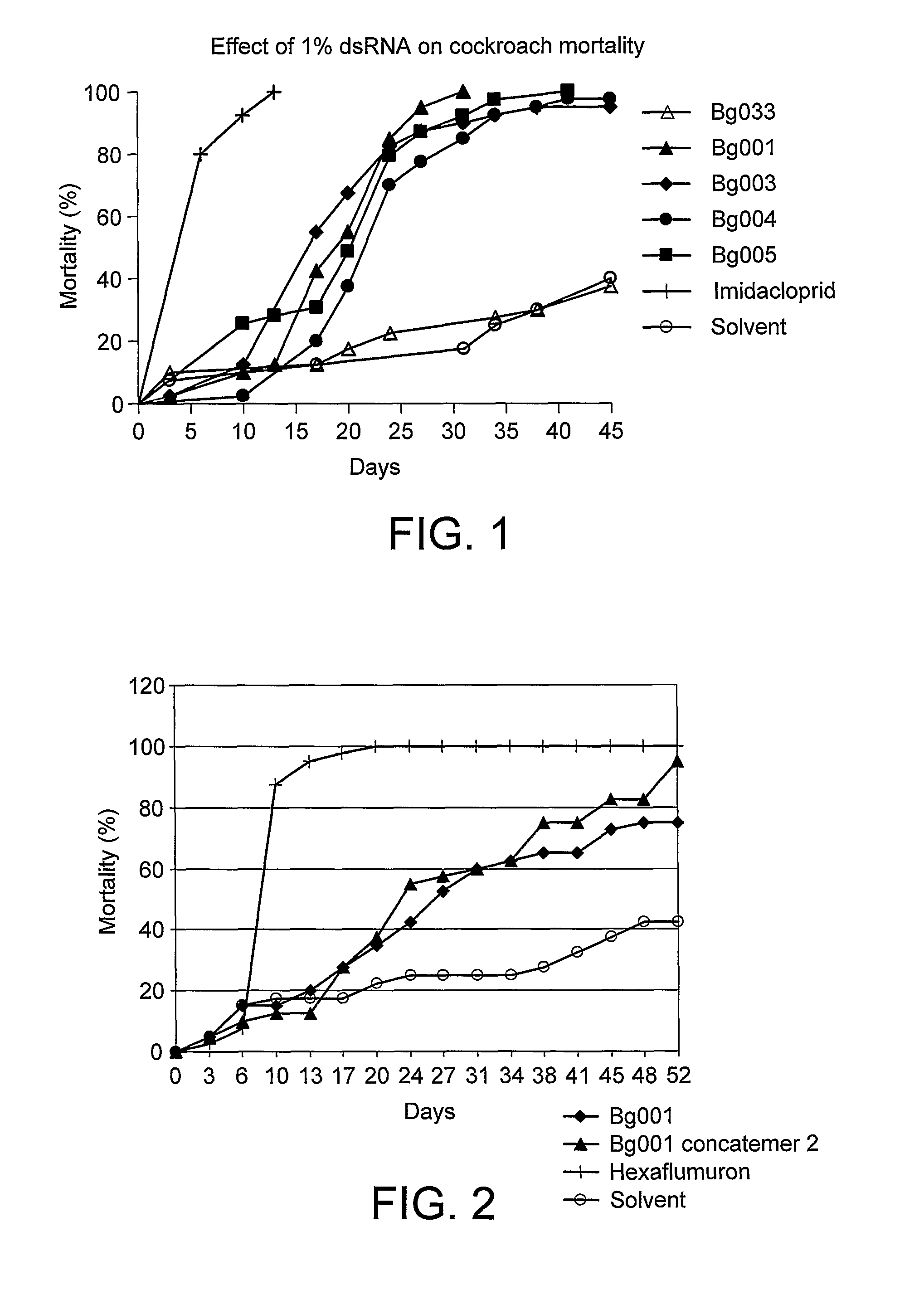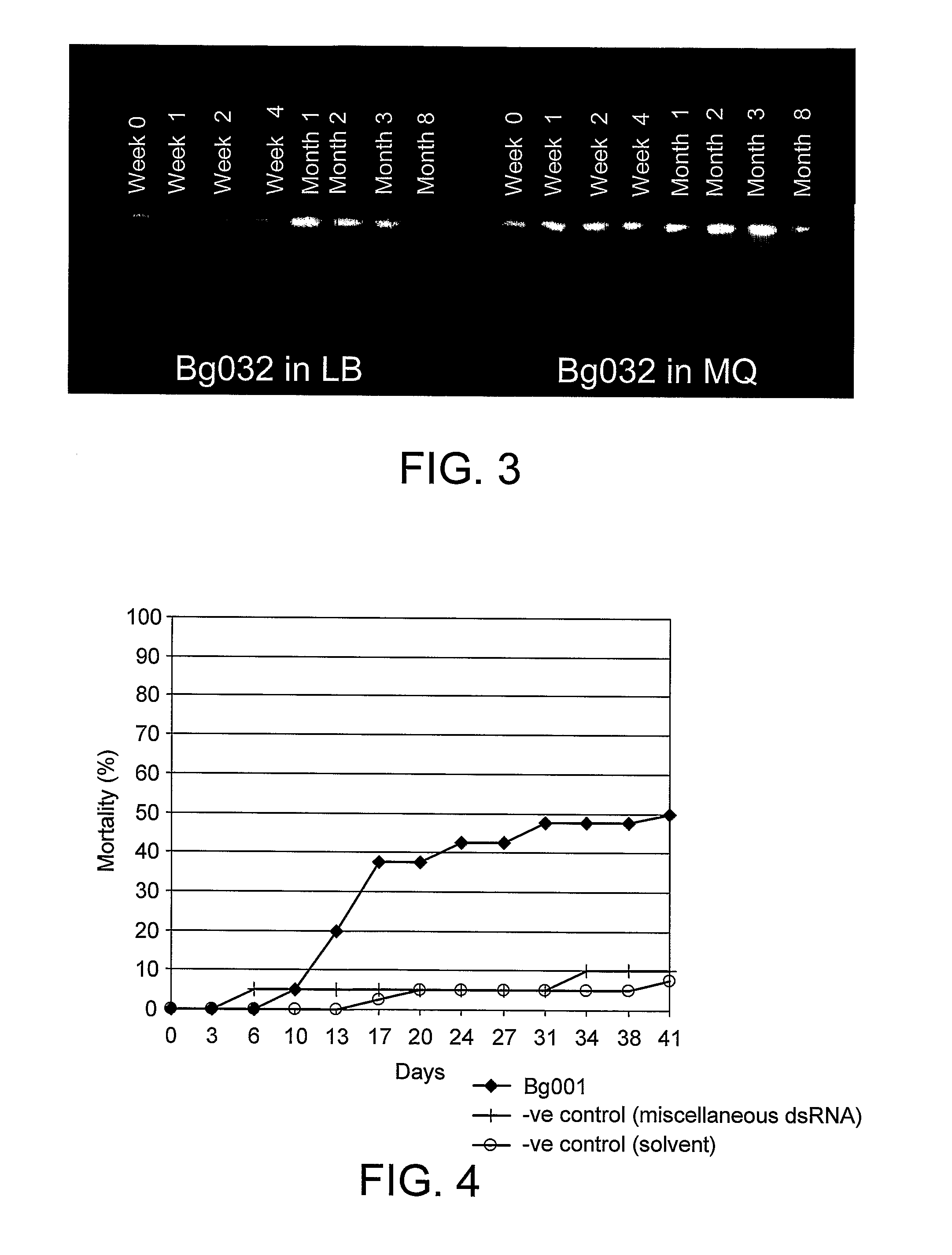RNAi for the control of insects and arachnids
a technology of rnai and insect, applied in the field of double-stranded rna (dsrna) mediated gene silencing in insect species, can solve the problems of insects posing health risks, destroying fabric and paper products, contaminating food and eating utensils,
- Summary
- Abstract
- Description
- Claims
- Application Information
AI Technical Summary
Benefits of technology
Problems solved by technology
Method used
Image
Examples
example 1
Cloning of a Partial Sequence of the Blattella germanica Bg001, Bg003, Bg004 and Bg005 Genes Via Family PCR
[0226]High quality, intact RNA was isolated from Blattella germanica (source: Central Science Laboratory, York) using TRIzol Reagent (Cat. No. 15596-026 / 15596-018, Invitrogen, Rockville, Md., USA) following the manufacturers directions. Genomic DNA present in the RNA preparation was removed by Dnase treatment as prescribed by the manufacturer. cDNA was generated using a commercially available kit (SuperScript™ III Reverse Transcriptase, Cat No 18080044, Invitrogen, Rockville, Md., USA) following the manufacturers directions.
[0227]To isolate cDNA sequences comprising a portion of the Bg001, Bg003, Bg004 and Bg005 genes, a series of PCR reactions with degenerate primers were performed using Amplitaq Gold (Cat. No. N8080240; Applied Biosystems) as prescribed by the manufacturer.
[0228]For Bg001, the degenerate primers oGBKA002 and oGBKA020 (represented herein as SEQ ID NO 3 and SEQ...
example 2
Cloning of a Partial Sequence of the Blattella germanica Bg031, Bg032 and Bg033 Genes Via EST Sequence
[0232]High quality, intact RNA was isolated from Blattella germanica (source: Central Science Laboratory, York) using TRIzol Reagent (Cat. No. 15596-026 / 15596-018, Invitrogen, Rockville, Md., USA) following the manufacturers directions. Genomic DNA present in the RNA preparation was removed by DNAse treatment as prescribed by the manufacturer. cDNA was generated using a commercially available kit (SuperScript™ III Reverse Transcriptase, Cat No 18080044, Invitrogen, Rockville, Md., USA) following the manufacturers directions.
[0233]To identify a partial cDNA sequence from the Bg031, Bg032 and Bg033 genes, one EST per gene was found in the public database Genbank under accession numbers AF260897, X73679 and AY004248 respectively, originating from the public database Genbank.
[0234]To isolate cDNA sequences comprising a portion of the Bg031, Bg032 and Bg033 genes, a series of PCR reactio...
example 3
dsRNA Production of the Blattella germanica Bg001, Bg003, Bg004, Bg005, Bg031, Bg032 and Bg033 Genes
[0238]dsRNA was synthesized in milligram amounts using the commercially available kit T7 RiboMAX™ Express RNAi System (Cat. No. P1700, Promega). First two separate single 5′ T7 RNA polymerase promoter templates were generated in two separate PCR reactions, each reaction containing the target sequence in a different orientation relative to the T7 promotor.
[0239]For Bg001 the sense T7 template was generated using the specific T7 FW primer oGBLD001 and the specific RV primer oGBLD010 (represented herein as SEQ ID NO 5 and SEQ ID NO 6 respectively) in a PCR reaction with the following conditions: 4 minutes at 95° C., followed by 35 cycles of 30 seconds at 95° C., 30 seconds at 51° C. and 1 minute at 72° C., followed by 10 minutes at 72° C. The anti-sense T7 template was generated using the specific FW primer oGBLD009 and the specific T7 RV primer oGBLD002 (represented herein as SEQ ID NO ...
PUM
 Login to View More
Login to View More Abstract
Description
Claims
Application Information
 Login to View More
Login to View More - R&D
- Intellectual Property
- Life Sciences
- Materials
- Tech Scout
- Unparalleled Data Quality
- Higher Quality Content
- 60% Fewer Hallucinations
Browse by: Latest US Patents, China's latest patents, Technical Efficacy Thesaurus, Application Domain, Technology Topic, Popular Technical Reports.
© 2025 PatSnap. All rights reserved.Legal|Privacy policy|Modern Slavery Act Transparency Statement|Sitemap|About US| Contact US: help@patsnap.com



